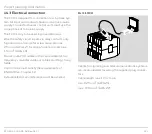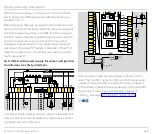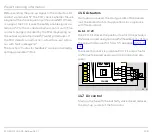
FCU 500, FCU 505 · Edition 02.17
124
Project planning information
14 .4 .2 Safety temperature limiter (STL)
If the maximum temperature limit value set in param-
eter 25 is exceeded or if an error occurs on the double
thermocouple (e.g. sensor discontinuity or short-cir-
cuit), the safety temperature limiter will trigger a fault
lock-out on the FCU. The safety interlock output will no
longer be set.
The double thermocouples must be positioned at the
warmest point in the combustion chamber so that they
can reliably detect whether the maximum temperature
limit value has been exceeded.
14 .4 .3 Temperature sensors (double thermocouples)
The FCU monitors connected temperature sensors for
cable discontinuity or short-circuit. For thermocouples,
this is only possible with double thermocouples. It is not
permitted to use single thermocouples and connect the
inputs in parallel using wire straps.
The temperature module (STM/STL) is designed so that
thermocouples of Types K, N and S can be connected.
Class 1 double thermocouples must be used to ensure
usage complies with the standards:
Thermocouple Application temperature
[°C]
Class 1 temperature range
[°C]
Type K
-270 to +1372
0 to +1200
Type N*
-270 to +1300
0 to +1200
Type S
-50 to +1768
0 to +1600
* Can be used as a substitute for Type K.
14 .4 .4 Thermocouples
Materials which are used for thermocouples are defined
in EN 60584. The temperature ranges for the various
materials and the expected voltages are also listed
there.
Type K: nickel-chromium/nickel-aluminium (NiCr-Ni)
This thermocouple is frequently used in industrial
measuring systems. The max. permanent operating
temperature is 1100°C. Type K can be used in the low
temperature range as low as -250°C. Type K features
lower stability and long-term drift at high temperatures
caused by oxidation.
Its accuracy is limited in the temperature range be-
tween 250°C and 600°C if temperatures change
quickly. In high temperatures, an adequately large wire
diameter should be selected to compensate for possi-
ble oxidation.
Type N: nickel-chromium-silicon/nickel-silicon
(NiCrSi-NiSi)
Compared to Type K, this thermocouple has similar
thermo-electric properties but is more resistant to oxi-
dation. This means that Type N features better resist-
ance to long-term drift and vastly improved stability
between 250°C and 600°C. Type N can be used in the
extended range from 0 to 1200°C. Type N thermocou-
ples are the highest quality thermocouples among the
non-precious types.
▼
















































